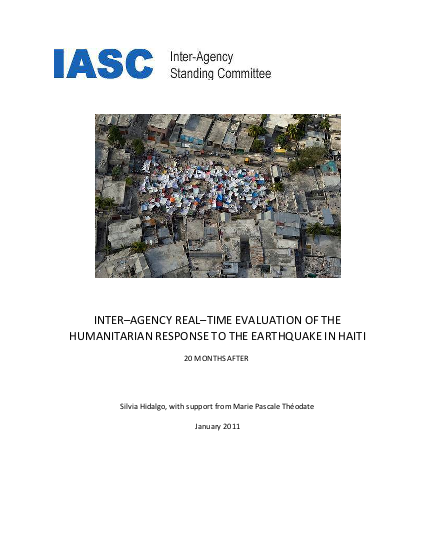
This report summarises the second phase of the Inter-Agency Standing Committee’s Inter-Agency Real-Time Evaluation of the response to the Earthquake, twenty months after the disaster event. The earthquake that struck Haiti on January 12th 2010 had a drastic effect on the country’s human and institutional public and the private sector capacity. An estimated 230,000 people lost their lives; 300,000 more were injured and over 1 million were left homeless. The devastating humanitarian situation was compounded by Haiti’s underlying vulnerabilities and high level of chronic poverty. In response, the international community mounted a massive humanitarian relief effort and fifty-five donors pledged a total of $4.59 billion in grants for 2010 and 2011 towards the rebuilding of the country.
Given the scale of the disaster and subsequent hum anitarian response, the Inter-Agency Standing Committee (IASC) launched a multiphase exercise to inform decision makers at national and headquarters levels, to draw lessons and allow corrections to be made where necessary. The Humanitarian Country Team (HCT) is intended to be the most immediate user of the feedback and recommendations of the evaluation.
The first phase of the Inter-Agency Real-Time Evaluation, completed in May 2010, covered the initial response. The second phase was initially foreseen to take place in October 20103 and focus in a forward-looking manner on inter-agency coordination problems or operational challenges during the transition phase. The process was postponed, due to the October 2010 cholera outbreak and the delays in starting the transition phase.
This second phase sought to:
- Analyze and provide lessons for the ongoing response, with a particular focus on coordination between different actors involved;
- Examine options for linking humanitarian response structures with longer-term and/or governmentestablished mechanisms; and
- Analyse the extent to which the findings and recommendations from the first phase of the Inter-Agency Real-Time Evaluation have informed the evolving humanitarian response in Haiti.
The evaluation found that the key achievements of the response have been: mainstreaming of disaster preparedness; an effective response in camps, with populations largely free of cholera; recent progress on the rate of rubble removal; implementation of integrated neighbourhood-based approaches; and progress in improving water and sanitation in the longer term. The main shortcomings include: durable solutions; livelihoods; accommodation; communication; and provision of continued support to address remaining needs. The evaluation has also identified many areas where data collection, needs analysis, consultation and communication, inter-agency action, and action with government need to be strengthened so that gains made are not lost as agencies phase out. The response in Haiti has been more expensive than in other recent emergencies (e.g., Pakistan, Sri Lanka) and has far exceeded initial estimates, with projects reported as exceeding projected costs by 2.5 to 3 times. Transition is on the agenda but needs a vision, a strategy, a plan, and leadership. There is a need for defining and understanding new roles and clarifying responsibilities in the move towards transition and development. Note that the data one cover page of the report is incorrectly given as January 2011 rather than January 2012, although the final file data is March 2012.
Links
Resource collections
- Evaluating humanitarian action
- Monitoring of humanitarian action
- UN Habitat - Urban Response Collection
- Urban Response - Urban Crisis Preparedness and Risk Reduction
- Urban Response Collection - Community Engagement and Social Cohesion
- Urban Response Collection - Economic Recovery
- Urban Response Collection - Environment and Climate Change
- Urban Response Collection - Housing, Land and Property
- Urban Response Collection - Urban Crisis Response, Recovery and Reconstruction
- Urban Response Collection - Urban Resilience